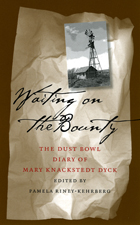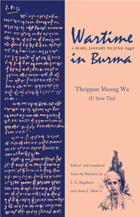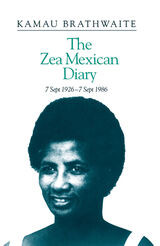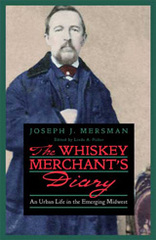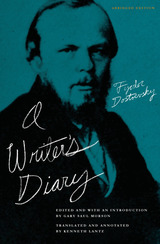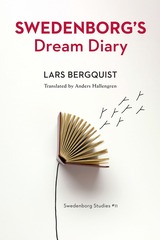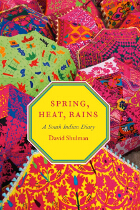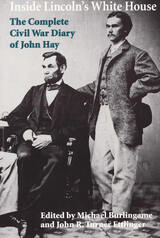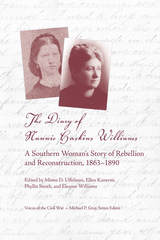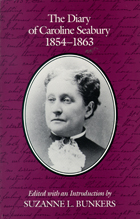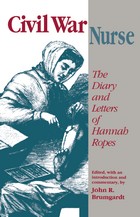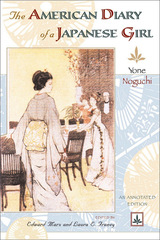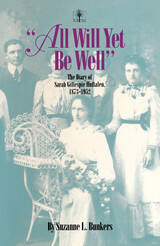DiariesCollection by Cassandra Verhaegen (13 items)Stories no longer under lock and key. Includes the following tags:
1688-1772, 1809-1865, 1865-1955, 1930-, 1949-, Annotated Edition, Asian American & Pacific Islander, Bunkers, Suzanne L., Cancer, Cultural & Regional, Diary, Dostoevsky, Fyodor, Dreams, Farm life, Hinduism, History, Military, India, Iowa, Jamaica, Lantz, Kenneth, Lincoln, Abraham, Marriage, Medical care, Missouri, Morson, Gary Saul, Mothers and daughters, Ohio, Patients, Psychology of Religion, Refugees, Shulman, David, Spring, Sweden, Swedenborg, Emanuel, Teachers, Tennessee
See More
|
Waiting On The Bounty
by Pamela Riney-Kehrberg
University of Iowa Press, 1999
The daughter of German immigrants, Mary Knackstedt married Henry Dyck, a Mennonite farmer, and in 1905 moved west to a settlement near Lamont Township in Hamilton County, Kansas. For the next thirty years they enjoyed growth and prosperity. Then the drought and dust storms that had driven many farmers from the region in the early years of the century returned. The Dycks remained on their farm and witnessed the mass exodus of farmers and townspeople—including close friends and family—who fled the Kansas wheat country to find work. Though she had only a fifth-grade education, Mary Knackstedt Dyck faithfully kept a diary. Written with pencil on lined notebook paper, her daily notations tell the story of farm life on the far western border of Kansas during the grim Dust Bowl years. Manuscript diaries from this era and region are extremely rare, and those written by farm women are even more so. From the point of view of a wife, mother, and partner in the farming enterprise, Dyck recorded the everyday events as well as the frustrations of living with drought and dust storms and the sadness of watching one's children leave the farm. A remarkable historical document, the diary describes a period in this century before the telephone and indoor plumbing were commonplace in rural homes—a time when farm families in the Plains states were isolated from world events, and radio provided an enormously important link between farmsteads and the world at large. Waiting on the Bounty brings us unusual insights into the agricultural and rural history of the United States, detailing the tremendous changes affecting farming families and small towns during the Great Depression. Pamela Riney-Kehrberg has provided an edited version of the diary entries from 1936 to 1941. Her informative introduction tells the story of the Dycks' settlement in western Kansas and places the diary in its historical context.
1
|
Wartime in Burma
by Muang Wa Theippan and Theippan Maung Wa
edited by L. E. Bagshawe and Anna Allott Ohio University Press, 2009
This diary, begun after the Japanese attack on Pearl Harbor and covering the invasion of Burma up to June 1942, is a moving account of the dilemmas faced by the well-loved and prolific Burmese author Theippan Maung Wa (a pseudonym of U Sein Tin) and his family. At the time of the Japanese invasion, U Sein Tin was deputy secretary in the Ministry of Home and Defense Affairs. An Oxford-trained member of the Indian Civil Service, working for the British administration on the eve of the invasion, he lived with his wife and three small children in Rangoon. Wartime in Burma is a stirring memoir that presents a personal account of U Sein Tin’s feelings about the war, his anxiety for the safety of his family, the bombing of Rangoon, and what happened to them during the next six chaotic months of the British retreat. The author and his family leave Rangoon to live in a remote forest in Upper Burma with several other Burmese civil servants, their staff, and valuable possessions—rich pickings for robbers. His diary ends abruptly on June 5, his forty-second birthday; U Sein Tin was murdered on June 6 by a gang of Burmese bandits. The diary pages, scattered on the floor of the house, were rescued by his wife and eventually published in Burma in 1966. What survives is a unique account that shines new light on the military retreat from Burma.
2
|
Zea Mexican Diary
by Kamau Brathwaite
foreword by Sandra Pouchet Paquet University of Wisconsin Press, 1993
In May of 1986 Edward Kamau Brathwaite learned that his wife, Doris, was dying of cancer and had only a short time to live. Responding as a poet, he began “helplessly & spasmodically” to record her passage in a diary. Zea Mexican is a collection of excerpts from this diary and other notes from this period of the Brathwaites’ lives, and few who read this book will fail to be caught up in the depth of Edward Brathwaite’s grief. Zea Mexican is a tribute to Doris Brathwaite and an exploration of the creative potency of love. (The title comes from the name Brathwaite gave Doris, who was originally from Guyana of part Amerindian descent.) Exposing the intimacy of his marriage, this book is the closest Brathwaite has ever come to an autobiographical statement. In examining his life with Doris he found the courage to reveal something of his own character. But, more than an autobiography, Zea Mexican is an extraordinary work of literature, much of it written in the expressive “nation language” of Jamaica and the Caribbean. Brathwaite filters his pain through his poetic gift, presenting it to the reader with all the poignancy poetry conveys.
3
|
The Whiskey Merchant’s Diary
by Joseph J. Mersman and Joseph J. Mersman
edited by Linda A. Fisher and Linda A. Fisher Ohio University Press, 2007
Joseph J. Mersman was a liquor merchant, a German American immigrant who aspired—successfully—to become a self-made man. Hundreds of the residents of Mersman’s hometown in Germany immigrated to Cincinnati in the 1830s, joining many thousands of other German immigrants. In 1847, at the age of twenty-three, Mersman began recording his activities in a bound volume, small enough to fit into his coat pocket. His diary, filled with work and play, eating and drinking, flirting and dancing, provides a unique picture of everyday life, first in Cincinnati and then in St. Louis, the new urban centers of the emerging Midwest. Outside of Gold Rush diaries and emigration journals, few narrative records of the antebellum period have been published. Illustrated with photographs, maps, and period advertisements, the diary reveals how a young man worked to establish himself during an era that was rich in opportunity. As a whiskey rectifier, Mersman bought distilled spirits, redistilled or reprocessed them to remove contaminants or increase the alcohol content, and added various flavorings before selling his product to liquor retailers. In his diary, he describes scrambling for capital, marketing his wares, and arranging transportation by steamboat, omnibus, and train. Although the business that he sought to master was eliminated by the passage of the Pure Food Law of 1906, Mersman, like most rectifiers, was a reputable wholesaler. Merchants like him played an important role in distributing liquor in nineteenth-century America. Mersman confronted serious disease, both as a sufferer from syphilis and as a witness to two devastating cholera epidemics. Unlike other residents of St. Louis, who fled the relative safety of the countryside, he remained in the city and saw the impact of the epidemics on the community. Linda A. Fisher’s extensive, insightful, and highly readable annotations add a wealth of background information to Mersman’s story. Her professional training and career as a physician give her a particularly valuable perspective on the public health aspects of Mersman’s life and times.
4
|
A Writer's Diary
by Fyodor Dostoevsky
edited by Gary Saul Morson introduction by Gary Saul Morson translated by Kenneth Lantz Northwestern University Press, 2009
The essential entries from Dostoevsky's complete Diary, called his boldest experiment in literary form, are now available in this abridged edition; it is a uniquely encyclopedic forum of fictional and nonfictional genres. A Writer's Diary began as a column in a literary journal, but by 1876 Dostoevsky was able to bring it out as a complete monthly publication with himself as an editor, publisher, and sole contributor, suspending work on The Brothers Karamazov to do so. The Diary's radical format was matched by the extreme range of its contents. In a single frame it incorporated an astonishing variety of material: short stories; humorous sketches; reports on sensational crimes; historical predictions; portraits of famous people; autobiographical pieces; and plans for stories, some of which were never written while others appeared later in the Diary itself. A range of authorial and narrative voices and stances and an elaborate scheme of allusions and cross-references preserve and present Dostoevsky's conception of his work as a literary whole. Selected from the two-volume set, this abridged edition of A Writer's Diary appears in a single paperback volume, along with a new condensed introduction by editor Gary Saul Morson.
5
|
Swedenborg's Dream Diary
by LARS BERGQUIST
Swedenborg Foundation Publishers, 2001
Swedish man of letters Lars Bergquist explains the often enigmatic but always fascinating dream journal kept by Emanuel Swedenborg from 1743 to 1744. A scientist, Swedenborg meticulously recorded his dreams and visions, adding interpretations that foreshadowed modern dream analysis. After an Easter vision in 1745, Swedenborg abandoned his scientific studies and dedicated his life to studying the inner meaning of Sacred Scripture. In his diary, he reveals his daily life and the reflections that are a key to understanding his later spiritual works.
6
|
Spring, Heat, Rains
by David Shulman
University of Chicago Press, 2008
“Rocks. Goats. Dry shrubs. Buffaloes. Thorns. A fallen tamarind tree.” Such were the sights that greeted David Shulman on his arrival in the South Indian state of Andhra Pradesh in the spring of 2006. An expert on South Indian languages and cultures, Shulman knew the region well, but from the moment he arrived for this seven-month sojourn he actively soaked up such simple aspects of his surroundings, determined to attend to the rich texture of daily life—choosing to be at the same time scholar and tourist, wanderer and wonderer. Lyrical, sensual, and introspective, Spring, Heat, Rains is Shulman’s diary of that experience. Evocative reflections on daily events—from explorations of crumbling temples to battles with ineradicable bugs to joyous dinners with friends—are organically interwoven with considerations of the ancient poetry and myths that remain such an inextricable part of life in contemporary India. With Shulman as our guide, we meet singers and poets, washermen and betel-nut vendors, modern literati and ancient gods and goddesses. We marvel at the “golden electrocution” that is the taste of a mango fresh from the tree. And we plunge into the searing heat of an Indian summer, so oppressive and inescapable that when the monsoon arrives to banish the heat with sheets of rain, we understand why, year after year, it is celebrated as a miracle. An unabashedly personal account from a scholar whose deep knowledge has never obscured his joy in discovery, Spring, Heat, Rains is a passionate act of sharing, an unforgettable gift for anyone who has ever dreamed of India.
7
|
Inside Lincoln's White House
edited by Michael Burlingame and John R. Turner Ettlinger
Southern Illinois University Press, 1999
On 18 April 1861, assistant presidential secretary John Hay recorded in his diary the report of several women that "some young Virginian long haired swaggering chivalrous of course. . . and half a dozen others including a daredevil guerrilla from Richmond named Ficklin would do a thing within forty eight hours that would ring through the world." The women feared that the Virginian planned either to assassinate or to capture the president. Calling this a "harrowing communication," Hay continued his entry: "They went away and I went to the bedside of the Chief couché. I told him the yarn; he quietly grinned." This is but one of the dramatic entries in Hay’s Civil War diary, presented here in a definitive edition by Michael Burlingame and John R. Turner Ettlinger. Justly deemed the most intimate record we will ever have of Abraham Lincoln in the White House, the Hay diary is, according to Burlingame and Ettlinger, "one of the richest deposits of high-grade ore for the smelters of Lincoln biographers and Civil War historians." While the Cabinet diaries of Salmon P. Chase, Edward Bates, and Gideon Welles also shed much light on Lincoln’s presidency, as does the diary of Senator Orville Hickman Browning, none of these diaries has the literary flair of Hay’s, which is, as Lincoln’s friend Horace White noted, as "breezy and sparkling as champagne." An aspiring poet, Hay recorded events in a scintillating style that the lawyer-politician diarists conspicuously lacked. Burlingame and Ettlinger’s edition of the diary is the first to publish the complete text of all of Hay’s entries from 1861 through 1864. In 1939 Tyler Dennett published Lincoln and the Civil War in the Diaries and Letters of John Hay, which, as Civil War historian Allan Nevins observed, was "rather casually edited." This new edition is essential in part because Dennett omitted approximately 10 percent of Hay’s 1861–64 entries. Not only did the Dennett edition omit important parts of the diaries, it also introduced some glaring errors. More than three decades ago, John R. Turner Ettlinger, then in charge of Special Collections at the Brown University Library, made a careful and literal transcript of the text of the diary, which involved deciphering Hay’s difficult and occasionally obscure writing. In particular, passages were restored that had been canceled, sometimes heavily, by the first editors for reasons of confidentiality and propriety. Ettlinger’s text forms the basis for the present edition, which also incorporates, with many additions and much updating by Burlingame, a body of notes providing a critical apparatus to the diary, identifying historical events and persons.
8
|
The Diary of Nannie Haskins Williams
edited by Minoa D. Uffelman, Ellen Kanervo, Eleanor Williams and Smith Phyllis
University of Tennessee Press, 2014
In 1863, while living in Clarksville, Tennessee, Martha Ann Haskins, known to friends and family as Nannie, began a diary. The Diary of Nannie Haskins Williams: A Southern Woman’s Story of Rebellion and Reconstruction, 1863–1890 provides valuable insights into the conditions in occupied Middle Tennessee. A young, elite Confederate sympathizer, Nannie was on the cusp of adulthood with the expectation of becoming a mistress in a slaveholding society. The war ended this prospect, and her life was forever changed. Though this is the first time the diaries have been published in full, they are well known among Civil War scholars, and a voice-over from the wartime diary was used repeatedly in Ken Burns’s famous PBS program The Civil War. Sixteen-year-old Nannie had to come to terms with Union occupation very early in the war. Amid school assignments, young friendship, social events, worries about her marital prospects, and tension with her mother, Nannie’s entries also mixed information about battles, neighbors wounded in combat, U.S. Colored troops, and lawlessness in the surrounding countryside. Providing rare detail about daily life in an occupied city, Nannie’s diary poignantly recounts how she and those around her continued to fight long after the war was over—not in battles, but to maintain their lives in a war-torn community. Though numerous women’s Civil War diaries exist, Nannie’s is unique in that she also recounts her postwar life and the unexpected financial struggles she and her family experienced in the post-Reconstruction South. Nannie’s diary may record only one woman’s experience, but she represents a generation of young women born into a society based on slavery but who faced mature adulthood in an entirely new world of decreasing farm values, increasing industrialization, and young women entering the workforce. Civil War scholars and students alike will learn much from this firsthand account of coming-of-age during the Civil War. Minoa D. Uffelman is an associate professor of history at Austin Peay State University. Ellen Kanervo is professor emerita of communications at Austin Peay State University. Phyllis Smith is retired from the U.S. Army and currently teaches high school science in Montgomery County, Tennessee. Eleanor Williams is the Montgomery County, Tennessee, historian.
9
|
Diary of Caroline Seabury
by Caroline Seabury
University of Wisconsin Press, 1991
In 1854 Caroline Seabury of Brooklyn, New York, set out for Columbus, Mississippi, to teach French at its Institute for Young Ladies. She lived in Columbus until 1863, through the years of mounting sectional bitterness that preceded the Civil War and through the turmoil and hardships of the war itself. During that time, her most intimate confidant was her diary. Discovered in the archives of the Minnesota State Historical Society, it is published here for the first time.
10
|
Civil War Nurse
by John R. Brumgardt
University of Tennessee Press, 1993
The chief nurse of the Union Hospital in Washington, D.C., describes life and stress in the hospital and comments on notable persons of power. Her heretofore unpublished diary and letters comprise a fresh, hightly significan document concerning the medical history of the Civil War and the contributions of women nurses in the Northern military hospitals. This book is edited, with Introduction and Commentary, by John R. Brumgardt.
See More
11
|
The American Diary of a Japanese Girl
edited by Edward Marx and Laura Franey
by Yone Noguchi Temple University Press, 2007
The first American novel by a writer of Japanese ancestry, The American Diary of a Japanese Girl is a landmark of modern American fiction and Japanese American transnationalism. First published in 1902, Yone Noguchi's novel describes the turn-of-the-century adventures of Tokyo belle Miss Morning Glory in a first-person narrative that The New York Times called "perfectly ingenuous and unconventional." Initially published as an authentic journal, the Diary was later revealed to be a playful autobiographical fiction written by a man. No less than her creator, Miss Morning Glory delights in disguises, unabashedly switching gender, class, and ethnic roles. Targeting the American fantasy of Madame Butterfly, Noguchi's New Woman heroine prays for "something more decent than a marriage offer," and freely dispenses her insights on Japanese culture and American lifestyles. With the addition of perceptive critical commentary and comprehensive notes, this first annotated edition sheds new light on the creative inventiveness of an important modernist writer.
12
|
All Will Yet Be Well
by Suzanne L. Bunkers
University of Iowa Press, 1993
Sarah Gillespie Huftalen led an unconventional life for a rural midwestern woman of her time. Born in 1865 near Manchester, Iowa, she was a farm girl who became a highly regarded country school and college teacher; she married a man older than either of her parents, received a college degree later in life, and was committed to both family and career. A gifted writer, she crafted essays, teacher-training guides, and poetry while continuing to write lengthy, introspective entries in her diary, which spans the years from 1873 to 1952. In addition, she gathered extensive information about the quietly tragic life of her mother, Emily, and worked to preserve Emily's own detailed diary. In more than 3,500 pages, Sarah writes about her multiple roles as daughter, sister, wife, teacher, family historian, and public figure. Her diary reflects the process by which she was socialized into these roles and her growing consciousness of the ways in which these roles intersected. Not only does her diary embody the diverse strategies used by one woman to chart her life's course and to preserve her life's story for future generations, it also offers ample evidence of the diary as a primary form of private autobiography for individuals whose lives do not lend themselves to traditional definitions of autobiography. Taken together, Emily's and Sarah's extraordinary diaries span nearly a century and thus form a unique mother/daughter chronicle of daily work and thoughts, interactions with neighbors and friends and colleagues, and the destructive family dynamics that dominated the Gillespies. Sarah's consciousness of the abusive relationship between her mother and father haunts her diary, and this dramatic relationship is duplicated in Sarah's relationship with her brother, Henry, Suzanne Bunkers' skillful editing and analysis of Sarah's diary reveal the legacy of a caring, loving mother reflected in her daughter's work as family member, teacher, and citizen. The rich entries in Sarah Gillespie Huftalen's diary offer us brilliant insights into the importance of female kinship networks in American life, the valued status of many women as family chroniclers, and the fine art of selecting, piecing, stitching, and quilting that characterizes the many shapes of women's autobiographies. Read Sarah's dairy to discover why "all will yet be well."
13
|
| Click here to go to the beginning. | |||||||||||||
